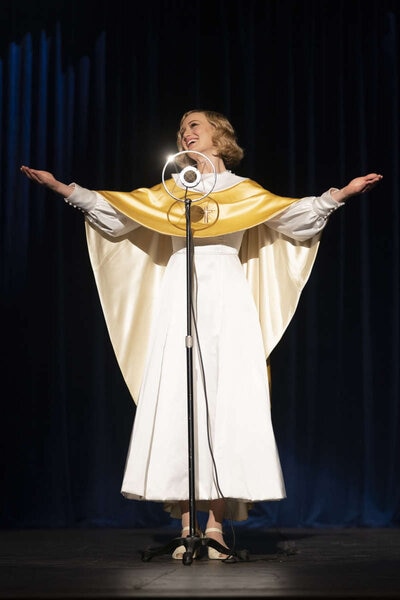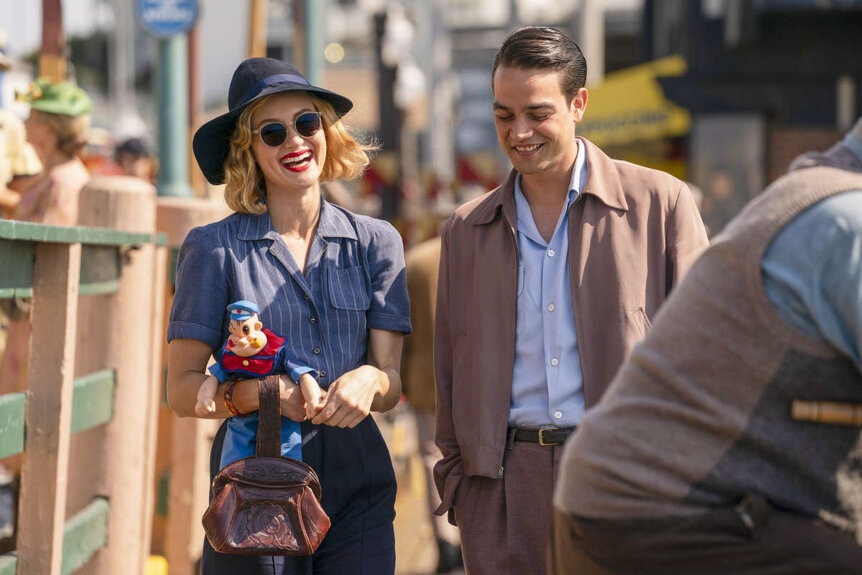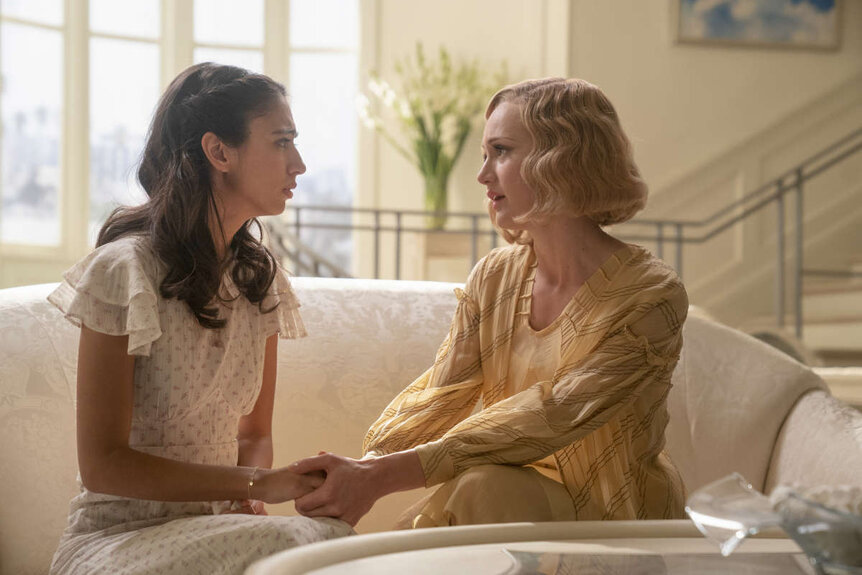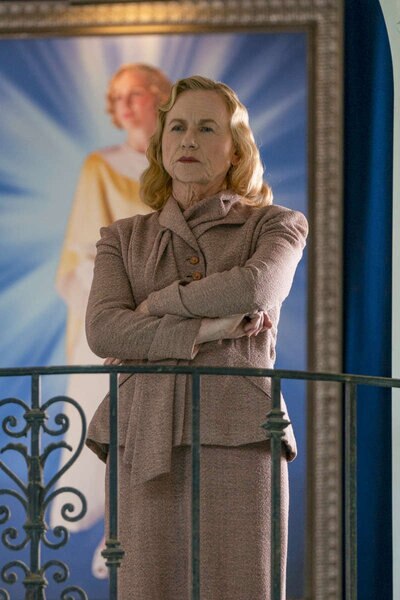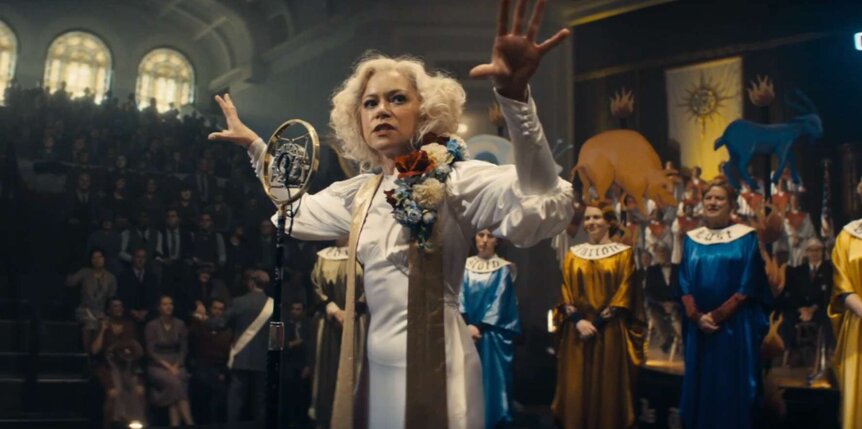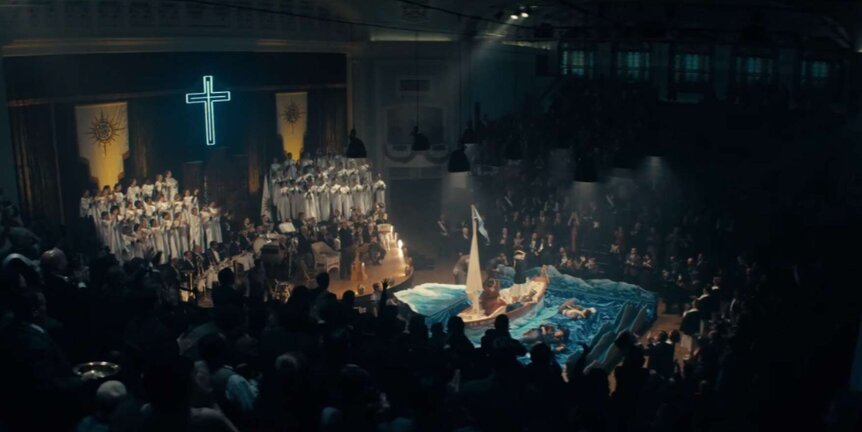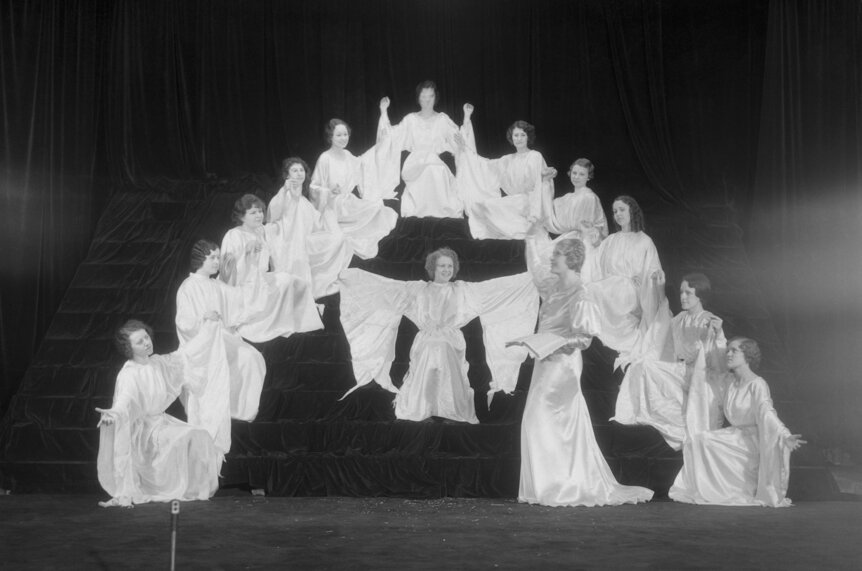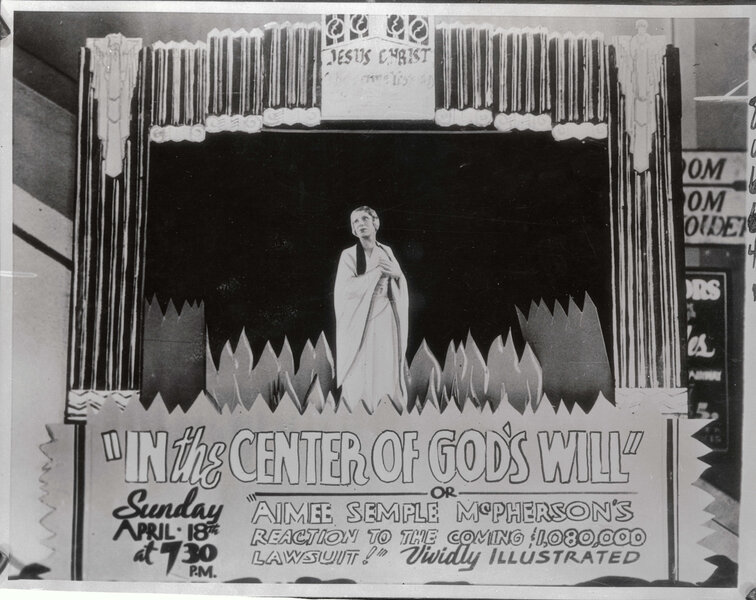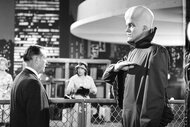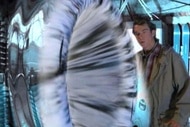Create a free profile to get unlimited access to exclusive videos, sweepstakes, and more!
The celebrity evangelist inspiration behind Penny Dreadful: City of Angels and Perry Mason
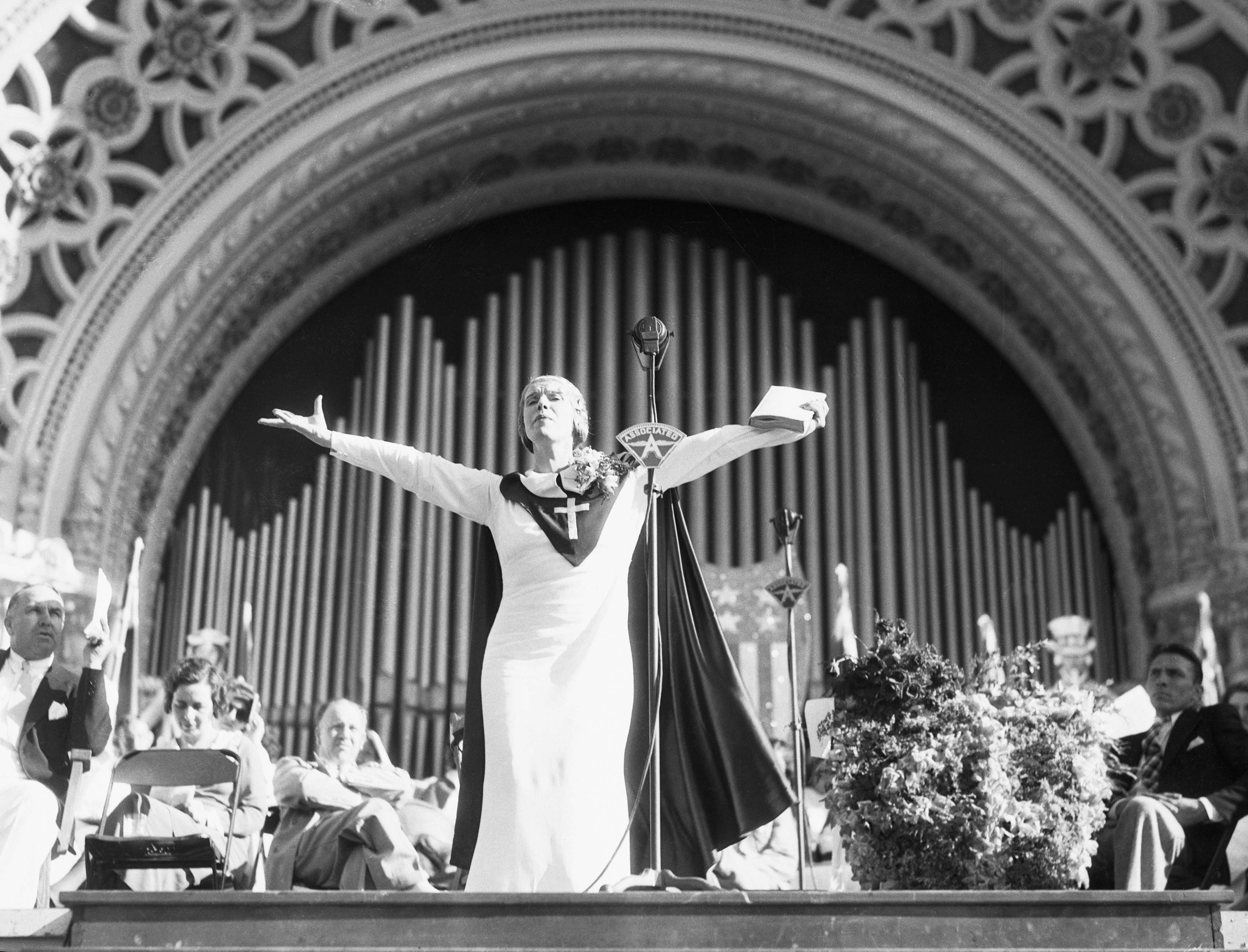
“The leading fundamentalist evangelist of the glittering '20s,” Aimee Semple McPherson is one of the first religious entertainers of the 20th century. A story made and set in Hollywood, Sister Aimee's celebrity reveals how little has changed over the last 100 years. Throngs of worshipers, media scrutiny, an allegedly faked kidnapping plot, divorce, multiple lawsuits, world tours, the claim she could heal the sick, and sermons with high production value all contribute to the continued fascination of this figure.
Sister Aimee was a source of inspiration for filmmakers as early as 1931 — when Frank Capra made The Miracle Woman — but two Los Angeles-set period TV shows have drawn on her stranger-than-fiction story this year. Religion, fame, and conspiracy are major components of the real-life events and the portrayal of a Sister Aimee-type figure in Penny Dreadful: City of Angels and Perry Mason (spoilers ahead for both).
Any depiction of L.A. in the 1930s can rely on a powder keg of issues to deliver conflict within each narrative. Penny Dreadful: City of Angels takes on the end of the decade as Europe edges closer to war, with the shape-shifting demon Magda (Natalie Dormer) appearing in various guises to stoke racial tension. The supernatural element of the Penny Dreadful spinoff addresses different religious iconography from Santa Muerte to the fictitious Joyful Voices Ministry. The latter utilizes technology by bringing Sister Molly Finister’s (Kerry Bishé) captivating sermons to the masses via radio.
Her angelic singing voice coupled with her movie-star good looks makes her an evangelical double threat, which has helped establish her celebrity within the community. Setting up shop in Hollywood as the movie industry soars is a no-brainer. At no point does Magda or any of her human forms interact with the religious figure; instead, Molly is an unknowing catalyst for events. Reputation is at the heart of her story, drawing inspiration on scandals that plagued the real Sister Aimee.
Men are the target of Magda’s work, be they the politician struggling for power or the impressionable teenage boy looking for his place in the world. The murder that kicks off the first episode is directly linked to Molly’s church, but her relationship with one of the victims is a very human love affair. Being torn between two different worlds dominates this spinoff; in the case of Detective Tiago Vega (Daniel Zovatto), his LAPD job is at odds with his Chicano roots and duty to protect his family's home.
While investigating the Hazlett family murders, his path crosses with Molly, and they discover a shared desire for normalcy. Molly’s only interaction from someone beyond the grave doesn’t occur until the final episode of the season, making this one of the most grounded aspects of this season. And unlike the real Sister Aimee or Tatiana Maslany’s take on this figure in Perry Mason, she doesn’t seem to believe she is an actual vector for God.
The ability to heal the sick simply by placing her hands on them is one of Sister Aimee’s big show party tricks. In Penny Dreadful, Molly appears to have the opposite effect. “The dying have a special grace, and I think he saw straight into my heart. Honestly, I didn't want him to live. I wanted his suffering to end and for him to be with God.” This confession to Tiago ends with her explaining the boy in the iron lung died a few days later prompting Molly's suicide attempt.
Often lacking agency — her mother controls her every move — Sister Molly's faith is put to the test throughout the series. She cannot be the virtuous woman everyone wants her to be and still retain a semblance of self. Her so-called gift from God is also a curse.
This version of Sister Aimee’s grand church eschews the bells and whistles — it is her voice that lures in worshipers as if she is an angel sent from heaven. Miss Adelaide (Amy Madigan) is essentially a stage mom, shaping her daughter in an image that will draw a larger audience, which is why she is so concerned when Molly's sermon takes a chilling turn. Palpable rage and a warning is not the Joyful Voices Ministry brand, which saw her being introduced in Episode 2 as "In the battle with Satan, armed with but a song and a smile." Her mother tasks a bodyguard to follow her 30-something daughter to protect her “virtue.” The real monster in Sister Molly’s storyline is the woman who brought her into the world and forced this life of leadership on her.
Mirroring the volatile real-life relationship between mother and daughter — the pair had a very public falling-out — this thread is replicated in both Penny Dreadful: City of Angels and Perry Mason. And while interfering demons trying to start a race war are absent from the latter, the more fantastical elements of the Sister Aimee storyline are reflected in this new HBO take on the iconic Erle Stanley Gardner crime series.
Penny Dreadful kicked off with a horrific multiple murder that was intended to spark tensions already bubbling against the Chicano community; meanwhile, Perry Mason opens with the horrific kidnapping gone wrong resulting in the death of an infant. As with Sister Molly’s involvement, the level as to which Sister Alice McKeegan (Tatiana Maslany) and The Radiant Assembly of God are involved at the beginning is unclear. However, Sister Alice inserts herself into the case by vouching for the mother of the deceased and newly accused suspect, Emily Dodson (Gayle Rankin). Emily’s greatest crime is seemingly an affair she had with one of the kidnappers. The morality police are willing to throw away the key, but the leader of this church is far more empathetic.
If Penny Dreadful stripped-down Sister Molly’s stage setup, Perry Mason is going all-in on the religion-meets-musical-theater of the real Angelus Temple. Sister Aimee biographer Matthew Sutton told the BBC in 2014, "She had the best actors, the best set designers, the best costumes, the best make-up artists and professional lighting. She would create these stories, these dramas in which biblical stories would come to life."
Sister Alice’s introduction in the second episode is during a New Year's Day sermon, ringing in 1932. Her stage presence is more than evident in her easy command of the congregation that feels like she an entertainer preaching the word of God. A neon cross — that could’ve been borrowed from Baz Luhrmann’s Romeo + Juliet — looms large behind the evangelical star. Her Jean Harlow blonde curls and commanding voice deliver a performance worthy of any movie studio, and it is no surprise A-list stars like Clark Gable are mentioned as attendees.
Emphasizing the power of evangelical radio in accumulating a global following, in real life, Sister Aimee courted huge swaths of followers stretching far beyond California. Even after the kidnapping scandal that dented her reputation, she was still greeted by 2000 fans in Los Angeles after returning from a world tour in 1928. Two years prior, she had gone missing while out for a swim in the sea — after an extensive search, she was presumed drowned.
Making front-page headlines, she reappeared 34 days later claiming she had been kidnapped and held in a shack in a Mexican border town (though she could never locate the building). The dramatic story included a sick baby used to lure her, a dramatic escape, and a $500,000 ransom (just over $7 million in 2020), which took a Hollywood-style twist when Sister Aimee was accused of faking the whole thing.
By September of that year, Sister Aimee had conspiracy charges against her, and her court appearance attracted fans and detractors. Instead of being held against her will in Mexico, she was accused of enjoying a getaway with a lover at a Carmel-by-the-Sea Californian location — Penny Dreadful features a seaside love nest for Molly and her beaus. Two years later she was accused of paying off judges with illicit bribes. These details read like a Hollywood movie, so it is no surprise she is still a lightning rod for creativity in stories depicting Los Angeles during this period.
At this early stage in Perry Mason, Sister Alice appears to be a true believer not only in God but in her abilities. After having a seizure mid-performance — dressed in tricorn hat naval officer regalia — she claims that not only did God speak to her, he also told her to resurrect murdered baby Charlie Dodson. Matters are made even more complicated when a member of the press overhears Sister Alice telling her mother of this auditory hallucination before she serenely drifts out to an imaginary sea (another link to the legend of Sister Aimee). What could be played off as stunt queen flex is negated by the sincerity of her actions.
No matter how hard the church elders (mostly men) try and spin this, they can’t take away her power. She is the face of this congregation, and despite the efforts of the men around her, her power emanates from this level of celebrity.
In a later moment — an image used in the trailer — a bloody nose coupled with wilder blonde curls gives her a Helena from Orphan Black appearance, suggesting she could be unraveling at the seams. To be told you can convene with God, heal the sick, and talk in tongues is a lot to put on anyone. No wonder she thinks she can bring a baby back from the dead. Her life has been one long miracle, so why not another one?
The trappings of fame exist whether you're a woman of God or an actress, and the real-life account of Sister Aimee is a cautionary tale still relevant today. Demons (real and imaginary) are hard to defeat when the press is caught up in the fray and the celebrity status of both evangelical leaders informs how they are treated in private and public. Penny Dreadful and Perry Mason take elements from Aimee Semple McPherson's life story — of which there is still much to unpack — in a bid to elevate the conflict at the heart of each narrative. In Penny Dreadful, the Joyful Voices Ministry grounds the supernatural, whereas the Perry Mason writers draw on the improbability of Sister Alice's claims to sow seeds of doubt. Faith acts in mysterious ways, but resurrection is a step into the far-fetched that makes us question those who are tasked with Sister Alice's well-being.
Both Sister Molly and Sister Alice are battling for the souls of their followers, as well as fighting for autonomy in a corrupt world. It is impossible to keep the devil at bay when those closest to these women are pulling the strings. The danger is coming from inside the temple.
